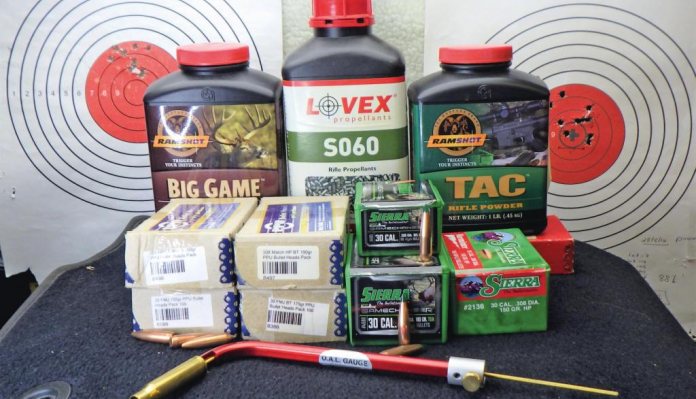Reloading Basics - Load Development
-
0
 Comments
Comments
- Last updated: 20/08/2021

Developing a load to match your rifle is one of the most rewarding things you can do as a reloader. Tweaking variables like the bullet, powder, and cartridge overall length (COL) gives you the ability to find the best performing load. All guns, even models from the same manufacturer are unique, due to manufacturing tolerances, and so will have their own ‘preferred load’. Different rifling twist rates and chamber tolerances also require particular ammunition to get the very best out of them.
The key to proper load development is using published data and only changing one variable at a time. Rifle manufacturers often provide a test target with a new gun, with important data like the bullet weight. This can be really useful because they will always use the ‘ideal’ bullet weight for that particular gun’s twist rate. This information provides a good starting point, but if you don’t have it then there are websites where you can find the optimum bullet weight for your gun. Try bergerbullets. com/twist-rate-calculator/
Assuming you have a bullet weight from the test target, a good reloading manual will include data matching that bullet with a variety of powders as well as recommendations on COL. It is then a matter of choosing one of the listed powders to begin reloading with. That particular powder may not prove to be the best performer in your rifle, but it is a place to start.
When experimenting with powders, you are looking for the charge that performs best with your bullet and gun. To home in on the optimum charge, load a series of rounds with various powder charges between the safe minimum and maximum weights listed in your manual. Starting with the minimum, load three rounds with each powder weight working upwards in half grain increments. Be sure to load all of the rounds exactly the same, except for the charge weight. Shoot a group with each load and see which charge shoots the most consistently. As you work through the weights, you might see your groups shrink down and then open back up again. Look for signs of excess pressure such as heavier recoil, difficult bolt lift, sticky extraction or flattened primers. Whichever charge weight gives the smallest groups is the one you should use for that bullet and powder combination in your rifle.
Having settled on a bullet and powder, you next work on the COL. Most bullets will have a performance ‘window’ of how much distance from the lands they shoot best with. When we talk about adjusting the COL, what we are actually referring to is controlling how far the bullet has to travel before it engages the lands of the rifling in the barrel. We control this distance by adjusting the bullet seating depth. Some rifles perform best when bullets are seated out long enough to touch the lands, but other bullets perform best when they have a certain amount of ‘jump’ to the lands.
The best way to find which COL works best with your bullet and rifle is to load and shoot a range of different lengths within safe limits. A good way to start is to begin loading cartridges to your rifle’s seating depth and then try cartridges progressively shorter in increments of a few thousandths. Load three cartridges at each length and be sure to load each cartridge exactly the same, except for the length. Whichever length produces the smallest group is the one to use for that bullet in your rifle.
A rifle’s ‘seating depth’ is the overall length of a cartridge that places the bullet in contact with the lands. It is unlikely that you will want to load your cartridges to this length, but you need to know what it is so that you can gauge how far off the lands you are loading your bullets. Reloaders will load bullets a particular distance off of the lands, expressed in thousandths of an inch. Knowing your rifle’s seating depth allows you to experiment with various seating depths while looking for the most accurate shooting COL.
There are different ways to measure the seating depth of your rifle but the most accurate way is to use a specialised seating depth tool like the Hornady O.A.L gauge. (COL and OAL/Overall Length mean the same thing.) It uses specially adapted calibre-specific cases to introduce a bullet into the start of the rifling and hold it in such a way to allow you to measure the seating depth. The ogive (curved area) of a bullet is the part that comes into contact with the lands, so measuring the seating depth will only give you a measurement that relates to that particular bullet.
Different bullets will have different ogive shapes, so keep this in mind when measuring and using seating depths. Blackening the bullet with a marker will make the marks produced by the lands easier to see, as the ink on the bullet will be scratched where the lands bite. When you want to load bullets a certain distance off of the lands, simply subtract the desired amount of ‘jump’ from the seating depth to get the desired COL. So, for example, a rifle’s seating depth = 3.430, the desired ‘jump’ to lands = 0.020, so load cartridges to a COL of 3.410.
If you enjoy experimenting, then even once you have found a load that works really well in your rifle, you will no doubt continue to experiment with different components. The great advantage of having gone through the process outlined above is that you have a reference load to compare and return to. As long as you work within safe limits, with published data, and only change one variable at a time, the quest for the perfect load can be endless.
